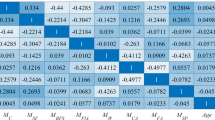Abstract
Fuzzy logic has recently been widely used to model in many areas of civil engineering applications. Especially as a result of the findings of experimental studies with fuzzy logic to predict good results have been obtained. In this study, Portland cement is composed of fly ash and silica fume with determined proportional. By this procedure, eight different mixtures were prepared and the effect of cement was investigated on the starting and finishing time of the setting. According to the results obtained in the setting time and finishing, all the mixing ratio of the prolonged period of time was determined. Also, by using fuzzy logic method, prediction model was formed based on the quantity of fly ash and silica fume to predict the initial and final setting times of cement, which could not be determined with experimental approaches. The experimental results are compared with the fuzzy logic results, and the correlation coefficients for the initial and final setting time are found 0.96 and 0.92, respectively. These results show that the developed model can be successfully applied in the cement industry.





Similar content being viewed by others
References
Fu X, Wang Z, Tao W, Yang C, Hou W, Dong Y, Wu X (2002) Studies on blended cement with a large amount of fly ash. Cem Concr Res 32(79):1153–1159
Worrell E, Martin N, Price L (2000) Potentials for energy efficiency improvement in the US cement industry. Energy 25(12):1189–1214
Yilmaz B, Ucar A, Oteyaka B, Uz V (2007) Properties of zeolitic tuff (clinoptilolite) blended Portland cement. Build Environ 42:3808–3815
Yilmaz B (2008) A study on the effects of diatomite blend in natural pozzolan blended cements. Adv Cement Res 20:13–21
Yildiz S, Balaydin I, Ulucan Z (2007) The Effect of rice husk ash on concrete strength. Sci Eng J Fırat Univ 19(1):85–91 (in Turkish)
Aruntas HY, Tokyay M (1996) The availability of diatomite as pozzolanic materials in the production of blended cement. Cem Concr World 1(4):3–41 (in Turkish)
Shiqun L, Della MR (1986) Investigation of relations between porosity, pore structure, and C1− diffusion of fly ash and blended cement pastes. Cem Concr Res 16(5):749–759
Prigione SG (1987) Portland-zeolite-cement for minimizing alkali-aggregate expansion. Cem Concr Res 17(3):404–410
Saraswathy V, Muralidharan S, Thangavel K, Srinivasan S (2003) Influence of activated fly ash on corrosion-resistance and strength of concrete. Cem Concr Compos 25(7):673–680
Homwuttiwong CS, Sirivivatnanon V (2004) Influence of fly ash fineness on strength, drying shrinkage and sulfate resistance of blended cement mortar. Cem Concr Res 34(7):1087–1092
Simsek O (2000) Building materials II. Ankara University Press, Ankara (in Turkish)
TS EN 197-1 (2002) Cement- Part 1: compositions and conformity criteria for common cements. Turkish Standards, Ankara. (in Turkish)
Celik MH, Simsek O, Sancak E (2001) The effect of silica fumes to initial and final of setting time of cement. J Polytech 4(4):55–60 (in Turkish)
Simsek O, Dur A, Yaprak H (2004) Properties of mortars added silica fume and superplasticizer. J Polytech 7(2):168–178 (in Turkish)
Celik MH, Aruntas HY, Baran Y (2003) () The effect of Seyitömer and Cayirhan thermal power plant fly ashes to initial and final setting time of PC-FA pastes. J Polytech 6(1):397–409 (in Turkish)
Dorum A, Tekin I (2004) The effect of distilled water to pressure strength and setting time of the fly ash replaced in cement paste. J Polytech 7(3):243–250 (in Turkish)
Guler I, Tunca A, Gulbandilar E (2008) Detection of traumatic brain injuries using fuzzy logic algorithm. Expert Syst Appl 34(2):1312–1317
Ozgan E, Yildiz K (2009) Prediction the effect of chrome magnesit brick dust on the starting and finishing setting time of Portland cement with fuzzy logic. J Fac Eng Architect Gazi Univ 24(2):257–264 (in Turkish)
Sarıdemir M (2009) Prediction of compressive strength of concretes containing metakaolin and silica fume by artificial neural Networks. Adv Eng Softw 40:350–355
Tanyildızi H (2009) Fuzzy logic model for the prediction of bond strength of high-strength lightweight concrete. Adv Eng Softw 40:161–169
Topcu IB, Saridemir M (2008) Prediction of compressive strength of concrete containing fly ash using artificial neural networks and fuzzy logic. Comput Mater Sci 41:305–311
Saridemir M (2009) Predicting the compressive strength of mortars containing metakaolin by artificial neural networks and fuzzy logic. Adv Eng Softw 40(9):920–927
Ozcan F, Atiş CD, Karahan O, Uncuoglu E, Tanyildiz H (2009) Comparison of artificial neural network and fuzzy logic models for prediction of long-term compressive strength of silica fume concrete. Adv Eng Softw 40(9):856–863
Subaşı S (2009) Prediction of mechanical properties of cement containing class C fly ash by using artificial neural network and regression technique. Sci Res Essay 4(4):289–297
Subasi S, Beycioglu A, Sancak E, Sahin I (2012) Rule-based Mamdani type fuzzy logic model for the prediction of compressive strength of silica fume included concrete using non-destructive test results. Neural Comput Appl. doi:10.1007/s00521-012-0879-4
Nazari A (2012) Utilizing ANFIS for prediction water absorption of light weight geopolymers produced from waste materials. Neural Comput Appl. doi:10.1007/s00521-012-0934-1
Subasi A, Yilmaz AS, Binici H (2009) Prediction of early heat of hydration of plain and blended cements using neuro-fuzzy modelling techniques. Expert Syst Appl 36:4940–4950
TS EN 196-3 (2002) Methods of testing cement-part 3: Determination of setting time and soundness. Turkish Standards, Ankara (in Turkish)
Hsu YL, Lee CH, Kreng VB (2010) The applications of fuzzy Delphi method and fuzzy AHP in lubricant regenerative technology selection. Expert Syst Appl 37:419–425
Ajayi AO, Aderounmu GA, Soriyan HA, David A (2010) An intelligent quality of service brokering model for e-commerce. Expert Syst Appl 37:816–823
Acknowledgments
The authors express their gratitude to Bursa Cement Plant executives, Quality Control Chief Sabiha KAN, and the staff for their invaluable contributions on this study.
Author information
Authors and Affiliations
Corresponding author
Rights and permissions
About this article
Cite this article
Gulbandilar, E., Kocak, Y. Prediction of the effects of fly ash and silica fume on the setting time of Portland cement with fuzzy logic. Neural Comput & Applic 22, 1485–1491 (2013). https://doi.org/10.1007/s00521-012-1049-4
Received:
Accepted:
Published:
Issue Date:
DOI: https://doi.org/10.1007/s00521-012-1049-4




